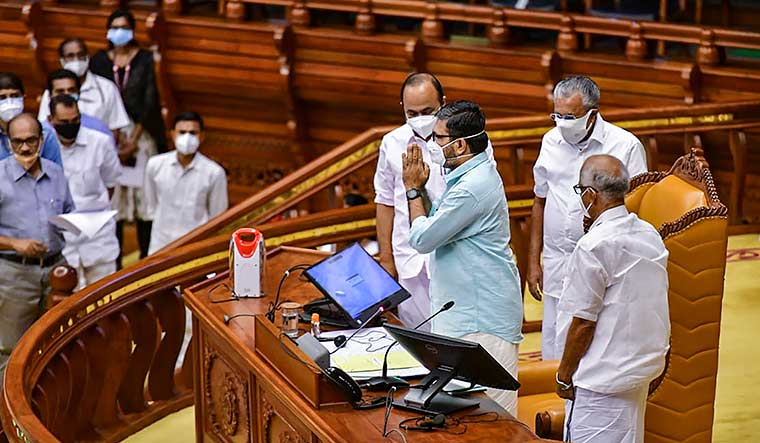LAST WEEK WAS QUITE a turning point in Kerala’s political history. To begin with, a chief minister who completed a full term took oath for the second consecutive time—a first. It also saw the end of a four-decade-long practice of exchanging power between the Congress-led United Democratic Front and the CPI(M)-led Left Democratic Front. And then, the Congress high command demolished the age-old groupism in the party in a single sweep.
It all started with Pinarayi Vijayan taking oath as chief minister on May 20 for the second consecutive time. Along with him, 20 were sworn in as ministers; 17 of them are first-timers. The average age of the cabinet is 59—Pinarayi is the oldest at 76, and Health Minister Veena George is the youngest at 44. And for the first time, the state has three women ministers—R. Bindu as higher education minister and J. Chinchu Rani as minister for animal husbandry, dairy development and milk cooperatives, apart from George, a former TV journalist.
The state had enjoyed political duopoly since 1982—the year the UDF and LDF had taken shape—with the two fronts alternately coming to power. But with the formation of the second LDF government, a new chapter has begun.
“The state has entered a new phase in politics. The character of the new LDF government is an indicator of that,” said political commentator Joseph C. Mathew. According to him, it is one of the most inclusive governments. “The new cabinet represents the new politics of the CPI(M),” he said. “The CPI(M) seems to have shed its ideological rigidities to become more inclusive.” As an example, he cited the instance of CPI(M) ministers taking oath in the “name of God”. “It was unthinkable till now,” said Mathew. “This new all-encompassing look may make the LDF more attractive electorally, but whether it is good for left politics is another question.”
That the state politics has undergone a total overhaul is a view shared across party lines. “A new era has begun,” said C.P. John, chairman of the UDF manifesto committee. “We will get to see many unprecedented things in the coming days and every political party will have to develop new skillsets to adapt to it.”
While the second coming of the LDF government under Pinarayi was indeed a game-changer, what was equally interesting was the appointment of V.D. Satheesan, 56, as the new opposition leader. The Congress high command overruled the opposition of the two tallest leaders in the state—former chief minister Oommen Chandy and former opposition leader Ramesh Chennithala, thereby putting a question mark on their clout within the “new Congress party”.
“Satheesan represents a new era in Congress politics, which will take the party to greater heights,” said newly elected MLA Mathew Kuzhalnadan. “The new age requires new leaders and a fresh political lingo and grammar.”
What prompted the high command—read Rahul Gandhi—to crush the infighting was the party’s dismal performance in the recently held assembly elections. Despite contesting in 93 seats against an incumbent government, the Congress won only 21. Heads had to roll, and Chennithala, the opposition leader for the last five years, was removed.
The appointment of Satheesan has certainly energised the Congress cadre. But the sulking among old timers is for all to see. “It was RG and his team that took every decision in this election,” said an MLA who had argued in favour of Chennithala. “Right from candidate selection to campaign modules, everything was decided by the All India Congress Committee team. We obeyed everything they said as we knew it was a fight for survival. But now, one person has been made the scapegoat. It is not fair.”
But a youth MLA who supported Satheesan said it was imperative that a new team leader head the new team. “Leaders like Chandy and Chennithala belong to the UDF-LDF duopoly times,” he said, adding that politics had changed, and hence the need for a new leader who understands that.
Meanwhile, the BJP, which had a high-decibel campaign, is on silent mode. What has its leaders worried more than the loss of its lone seat is the reality that the vote share of the National Democratic Alliance fell from 15.2 per cent to 12.47 per cent.
Said a top RSS functionary, “There is a credibility crisis for the party. Had we won at least two seats, there would have been a huge inflow of leaders from the Congress. But since that has not happened, the road ahead seems to be tougher.”
According to political commentators, the striking feature of the “new politics” is that the CPI(M) has taken over the Congress’s political space. “The CPI(M) is no longer a communist party in the conventional sense,” said Mathew. “For instance, it implements Nehruvian socialism in a better way than the Congress. Also, the CPI(M), which has more or less shed its class politics, has become appealing to many sections who, hitherto, were UDF supporters. How the Congress will be able to tackle this will determine its future.”
The new opposition leader, meanwhile, is determined to make a mark in the assembly bereft of the BJP. “I represent new politics,” said Satheesan. “The aspirations and concerns of the new age are different and our politics should reflect that.”
And, it is not an impossible task, considering that the party alone won 25 per cent of the vote share despite the pro-LDF wave in the recent election. The Congress still has its loyal vote banks even though the CPI(M) has started making inroads.
“To survive, the Congress needs to remove the lens of the 1990s and start looking at politics with a fresh perspective,” said John. “It has to stop its overdependence on media and start strengthening the UDF structure from the ground.”


